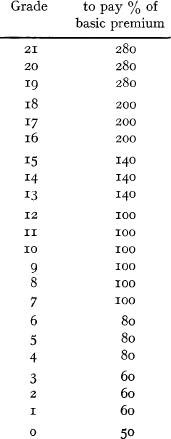Crossref Citations
This article has been cited by the following publications. This list is generated based on data provided by
Crossref.
1971.
A Review of the Scope for Using Claims Histories of Individual Policies in Risk Assessment..
Journal of the Institute of Actuaries,
Vol. 97,
Issue. 2-3,
p.
202.
Albrecht, Peter
1985.
An Evolutionary Credibility Model for Claim Numbers.
ASTIN Bulletin,
Vol. 15,
Issue. 1,
p.
1.
Bühlmann, H.
1992.
Stochastic discounting.
Insurance: Mathematics and Economics,
Vol. 11,
Issue. 2,
p.
113.
Dannenburg, Dennis
1994.
Some results on the estimation of the credibility factor in the classical Bühlmann model.
Insurance: Mathematics and Economics,
Vol. 14,
Issue. 1,
p.
39.
Hazewinkel, M.
1997.
Encyclopaedia of Mathematics.
p.
168.
Goulet, Vincent
1998.
A note on optimal parameter estimation under zero-excess assumptions.
Insurance: Mathematics and Economics,
Vol. 23,
Issue. 2,
p.
111.
de Alba, Enrique
2001.
“Principal Applications of Bayesian Methods in Actuarial Science: A Perspective”, Udi E. Makov, October 2001.
North American Actuarial Journal,
Vol. 5,
Issue. 4,
p.
69.
Makov, Udi E.
2001.
Principal Applications of Bayesian Methods in Actuarial Science.
North American Actuarial Journal,
Vol. 5,
Issue. 4,
p.
53.
Cossette, Hélène
and
Luong, Andrew
2003.
Generalized least squares estimators for covariance parameters for credibility regression models with moving average errors.
Insurance: Mathematics and Economics,
Vol. 32,
Issue. 2,
p.
281.
LINACRE, NICHOLAS A.
STEWART‐OATEN, ALLAN
BURGMAN, MARK A.
and
ADES, PETER K.
2004.
Incorporating Collateral Data in Conservation Biology.
Conservation Biology,
Vol. 18,
Issue. 3,
p.
768.
Norberg, Ragnar
2004.
Encyclopedia of Actuarial Science.
Antonio, Katrien
and
Beirlant, Jan
2007.
Actuarial statistics with generalized linear mixed models.
Insurance: Mathematics and Economics,
Vol. 40,
Issue. 1,
p.
58.
Dornheim, Harald
and
Brazauskas, Vytaras
2007.
Robust and Efficient Methods for Credibility When Claims Are Approximately Gamma-Distributed.
North American Actuarial Journal,
Vol. 11,
Issue. 3,
p.
138.
Ai, Jing
and
Brockett, Patrick L.
2008.
Encyclopedia of Quantitative Risk Analysis and Assessment.
Goulet, Vincent
2008.
Encyclopedia of Quantitative Risk Analysis and Assessment.
Garrido, José
and
Zhou, Jun
2009.
Full Credibility with Generalized Linear and Mixed Models.
ASTIN Bulletin,
Vol. 39,
Issue. 1,
p.
61.
Belhadj, Hassine
Goulet, Vincent
and
Ouellet, Tommy
2009.
On Parameter Estimation in Hierarchical Credibility.
ASTIN Bulletin,
Vol. 39,
Issue. 2,
p.
495.
Afonso, Lourdes B.
Reis, Alfredo D. Egídio dos
and
Waters, Howard R.
2010.
Numerical Evaluation of Continuous Time Ruin Probabilities for a Portfolio with Credibility Updated Premiums.
ASTIN Bulletin,
Vol. 40,
Issue. 1,
p.
399.
Gisler, Alois
2010.
Encyclopedia of Quantitative Finance.
Lai, Tze Leung
and
Sun, Kevin Haoyu
2012.
Evolutionary Credibility Theory.
North American Actuarial Journal,
Vol. 16,
Issue. 2,
p.
273.

